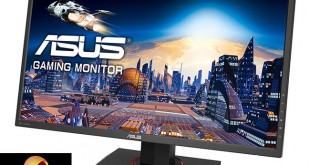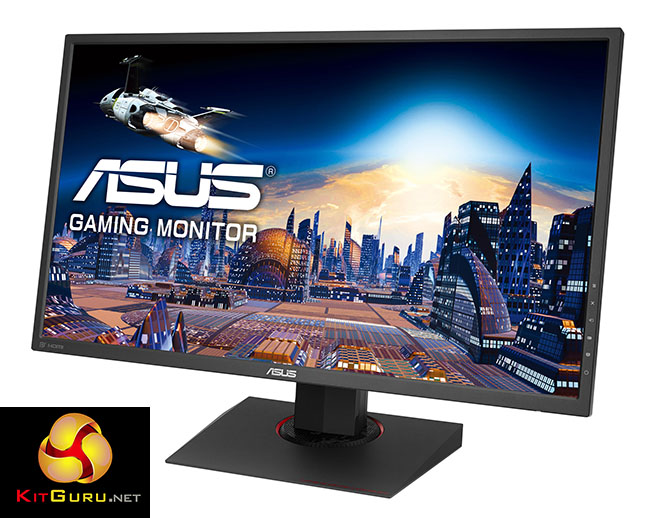
The Asus MG278Q is a 27-inch WQHD (2,560×1,440) TN gaming display that supports AMD FreeSync adaptive-sync technology. When in adaptive-sync mode, it’s capable of a wider frequency range than its IPS cousin, the MG279Q, as it can go from 35Hz all the way to 144Hz. And being a TN panel it has a fast response time of just 1ms – this is a display for people with AMD graphics cards who want gaming without tearing and micro-stutter across a wide frequency range with the lowest response time possible.
If you’ve read our analysis of the Asus MG279Q (review HERE) … an IPS display that supports AMD FreeSync, you might get a sense of deja vu when you see the MG278Q. It’s similarly a 27-inch gaming monitor with a WQHD screen resolution (2,560×1,440) and much of the external design is identical.

There’s one major difference though. The MG278Q is a TN panel, which means it can handle a wider range of FreeSync frequencies than any IPS panel can. The MG279Q supports FreeSync between 35Hz and 90Hz, while the MG278Q can go all the way to 144Hz when in FreeSync mode.
Asus has a small leg up on its competitors at the lower bound of this range. The majority of FreeSync displays start at 40Hz, below which FreeSync is not supported and frames drift back into the standard non-sync format.
But with both the MG279Q and MG278Q, it starts at 35Hz. This means that a wider range of frame rates are supported in adaptive-sync mode, giving you a bit of extra headroom when adjusting detail settings in games. If you crank up the detail and your frame rate drops, the display and GPU will remain in sync as low as 35fps (and it’s questionable whether below 35fps is a playable frame rate anyway).
And since it’s a TN panel, it has a 1ms response time too, while the IPS panel in the MG279Q is slower, rated at 4ms.
On the flip side, IPS screens generally look better on the Windows desktop than TN panels, with improved viewing angles and colour uniformity, so there’s a clear choice to be made between TN and IPS with the two 144Hz Asus FreeSync displays. Better overall gaming performance, with minimal ghosting and a wider FreeSync range with TN, or (perhaps subjectively) better overall picture quality with IPS, but a limit to the FreeSync range it supports (although both screens will handle 144Hz just fine).
We should also mention that for people who want a G-Sync display, Asus currently only sells a TN panel, the ROG Swift PG278Q, with an IPS G-Sync screen called the PG279Q penciled in for a Q3 2015 release, and a 4K G-Sync display also on the way.
There are a few other differences between the two screens as well. We noticed some minor cosmetic differences, a few new options in the on-screen display (OSD) and a slight adjustment to the video inputs.
There’s also a considerable difference in pricing, mainly down to TN panels being cheaper to produce than IPS. This alone certainly makes it far more attractive. Asus hasn’t yet revealed its final pricing for the MG278Q, but has suggested it will be £150-200 cheaper than the MG279Q. That display retails for around £500, so expect to pay in the region £300-350 for the MG278Q, which is fairly competitive with other FreeSync displays, although you’re still paying a bit more than you would for a standard gaming display.
Asus MG278Q features:
- 27-inch, WQHD 2560 x 1440 resolution display with TN panel technology.
- 144Hz refresh rate and AMD FreeSync™ technology
- ASUS-exclusive Ultra-Low Blue Light, Flicker-Free, GamePlus, and GameVisual technologies
- Ergonomically-designed stand with full tilt, swivel, pivot, and height adjustment
 KitGuru KitGuru.net – Tech News | Hardware News | Hardware Reviews | IOS | Mobile | Gaming | Graphics Cards
KitGuru KitGuru.net – Tech News | Hardware News | Hardware Reviews | IOS | Mobile | Gaming | Graphics Cards



===
How can a TN be better for gaming comparing to mg279q? IPS is always better with its image quality.
TN is better for competitive gaming because of it’s 1ms response time, such as FPS or RTS.
IPS is better for cinematic experience because of its wider range of colors, such as RPG.
Too expensive for TN. These TN panels need a price drop, they’ve been stagnant for years. A 24″ 1080p 144hz TN should be $199 and a 27″ 1440p 144hz TN should be $299.
I also encounter the issue where the monitor occasionally goes black for a few seconds. For me it seems to be indirectly related to GPU load, and more specifically to GPU voltage (they scale together). As soon as my 290X reaches ~ 1.25V, the screen goes black. This happens periodically in GPU intensive games, but can more easily be triggered by offsetting the VDDC voltage +50mV in any overclocking utility.
Could someone who owns this screen verify this?
“or whatever refresh rate the screen is set to” What other refresh rate settings can you use? I know a few other monitors have the options for 144, 120 and 60. what does this one do?
I ended up getting one of these on sale for $399 :p It’s a really good monitor as stated in this review, i really am impressed with this top tier 8bit TN panel which looks amazing. I’ll be good with this monitor for another 6-7years till 4k becomes mainstream 🙂
dude it pisses me off that im trying to find a new monitor and these old ass monitors are still so high priced, then i see your comment from a year ago on the one monitor i thought might be right. great.
Ya i know, i commented a year ago on its high price and wished it cost $299usd. I ended up finding this monitor on sale for $399usd and just made the jump cause my eyes needed a treat and were getting wrecked with a normal monitor. The low blue light and no flickering is amazing and helps tremendously with long sessions. GL with your decision, i don’t think monitors will go down in price anytime soon as they keep tweaking a tiny feature and keep the price high and then discontinue the older models.
im struggling to find anything that can compete for price to be honest. from an owner perspective is it good? might have to just bite the bullet
Ya its great, i have no real complaints. It even has a great freesync range of 35-144hz
Do you like anti-glare coating on this monitor (MG278Q)
ya it works and it doesn’t dull the screen or colors at all. For comparison the BenQ xl2411Z seems like a grainy overlay on top of the screen vs this one which you can’t notice at all unless you put your face to the screen.